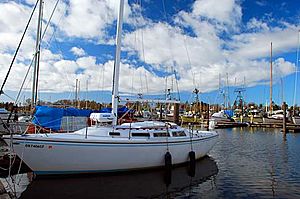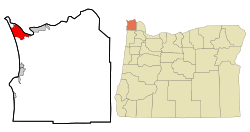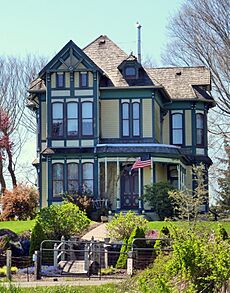Warrenton, Oregon facts for kids
Quick facts for kids
Warrenton, Oregon
|
|
|---|---|

Warrenton marina
|
|
| Motto(s):
"Making a Difference through excellence of service"
|
|

Location in Oregon
|
|
| Country | United States |
| State | Oregon |
| County | Clatsop |
| Incorporated | 1899 |
| Area | |
| • Total | 17.03 sq mi (44.11 km2) |
| • Land | 12.66 sq mi (32.78 km2) |
| • Water | 4.37 sq mi (11.33 km2) |
| Elevation | 7 ft (2 m) |
| Population
(2020)
|
|
| • Total | 6,277 |
| • Density | 495.93/sq mi (191.49/km2) |
| Time zone | UTC−08:00 (Pacific) |
| • Summer (DST) | UTC−07:00 (Pacific) |
| ZIP code |
97146
|
| Area code(s) | 503 and 971 |
| FIPS code | 41-78900 |
| GNIS feature ID | 2412184 |
| Website | www.ci.warrenton.or.us |
Warrenton is a cool city right on the coast in Clatsop County, Oregon. It's named after an early settler, D.K. Warren. People here mostly work in fishing and logging. About 6,277 people lived here in 2020. Warrenton is a quieter place, not far from Astoria, which is the main city in Clatsop County.
Contents
The Story of Warrenton
Before settlers arrived, the Clatsop tribe of Native Americans lived here. Their land stretched from the Columbia River to Tillamook Head. Clatsop County is named after this tribe. The famous Lewis and Clark Expedition also had their last camp nearby. Today, you can visit a copy of Fort Clatsop just outside Warrenton.
Early Settlers and First Towns
The first pioneers came to the Warrenton area between 1845 and the early 1850s. These included Jeremiah Gerome Tuller, J. W. Wallace, D. E. Pease, Ninian A. Eberman, and George Washington Coffenbury. Coffenbury is still remembered today. A lake in Fort Stevens is named after him.
The first town in Warrenton was Lexington, started in 1848. It was the first main town for Clatsop County. Later, people stopped using the name Lexington. The area became known as Skipanon. This name lives on with the Skipanon River, which flows through the city. There was a Lexington post office from 1850 to 1857. A Skipanon post office was open from 1871 to 1903.
Fort Stevens and City Growth
In 1863, a military base called Fort Stevens was built near the mouth of the Columbia River. Soldiers used the fort until 1947. Now, the old fort is part of Fort Stevens State Park.
Not much changed in the area until the early 1870s. That's when D. K. Warren bought land from the first settlers. With help from Chinese workers, Warren built a long wall, called a dike, about 2.5 miles (4 km) long. This dike was finished in 1878 and helped protect the land from floods. Warren planned the town around 1891. The next year, he built the first schoolhouse for $1,100 and gave it to the school district.
Warrenton was officially planned in 1889. It became a city in 1899. The city was built on flat, wet land near the river. It needed the dikes built by Chinese laborers to stop the Columbia River from flooding the town.
Where is Warrenton Located?
Warrenton is in the very northwest part of Oregon. It's about 5 miles (8 km) west of Astoria. You cross the Youngs Bay bridge to get there. This bridge is over 4,200 feet (1,280 m) long. It crosses the Youngs Bay estuary, which is where the Columbia River meets the ocean.
Land and Water
The city covers a total area of about 17.66 square miles (45.74 square kilometers). About 12.77 square miles (33.07 square kilometers) is land. The other 4.89 square miles (12.67 square kilometers) is water.
Warrenton has two important fishing ports. One is a charter fishing port in Hammond. The other is a big commercial fishing port in downtown Warrenton.
Neighboring Communities
Warrenton is made up of several smaller communities that used to be separate. These include Flavel, Fort Stevens, Hammond, Lexington, and Skipanon. The Fort Stevens post office was open from 1899 to 1949. Hammond joined Warrenton in December 1991. Hammond was named after Andrew B. Hammond, who built the Astoria and Columbia River Railroad. Hammond used to be a Clatsop village called Ne-ahk-stow. It still has its own ZIP Code, 97121, but it's now part of Warrenton.
Warrenton's Weather
Warrenton has mild, dry summers. The average monthly temperature never goes above 71.6°F (22°C). It's often cloudy or rainy because it's so close to the ocean. But it does get some sunny days too! This type of weather is called a warm-summer Mediterranean climate.
How Many People Live in Warrenton?
| Historical population | |||
|---|---|---|---|
| Census | Pop. | %± | |
| 1900 | 332 | — | |
| 1910 | 339 | 2.1% | |
| 1920 | 730 | 115.3% | |
| 1930 | 683 | −6.4% | |
| 1940 | 1,365 | 99.9% | |
| 1950 | 1,896 | 38.9% | |
| 1960 | 1,717 | −9.4% | |
| 1970 | 1,825 | 6.3% | |
| 1980 | 2,493 | 36.6% | |
| 1990 | 2,681 | 7.5% | |
| 2000 | 4,096 | 52.8% | |
| 2010 | 4,989 | 21.8% | |
| 2020 | 6,277 | 25.8% | |
| source: | |||
Population in 2020
In 2020, the city had 6,277 people. There were 2,715 homes, with 2,497 of them lived in. Most residents, about 82.1%, were White. About 1.2% were Native American, and 1.6% were Asian. About 9.1% of the population was Hispanic or Latino. Almost 23% of the people were under 18 years old.
Population in 2010
In 2010, there were 4,989 people living in Warrenton. There were 1,948 households, and 1,287 families. The city had about 390.7 people per square mile (150.8 per square kilometer). Most people, 91.5%, were White. About 5.7% of the population was Hispanic or Latino.
About 31.3% of households had kids under 18. Almost half, 48.5%, were married couples. The average household had 2.45 people. The average family had 2.95 people. The average age in the city was 37.6 years. About 23.8% of residents were under 18. And 14% were 65 or older. The population was almost evenly split between males (51.0%) and females (49.0%).
Schools in Warrenton
Warrenton has a few schools. Warrenton High School is a smaller school with 300 to 400 students. Warrenton Grade School used to teach students from kindergarten to 8th grade. It had about 700 students.
In 2021, Warrenton Middle School opened. It's located east of Highway 101. Now, Warrenton Grade School has about 480 students. The new middle school has about 250 students. All three schools share the same mascot: the "Warrior."
Famous People from Warrenton
- Brian Bruney, a professional baseball pitcher
- Clara C. Munson, the first woman elected mayor in Oregon in the 1900s
- Janet Stevenson, a writer
Images for kids
See also
 In Spanish: Warrenton (Oregón) para niños
In Spanish: Warrenton (Oregón) para niños




